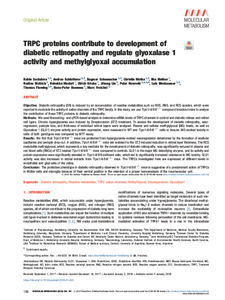Por favor, use este identificador para citar o enlazar este ítem:
https://repositorio.uca.edu.ar/handle/123456789/8705| Campo DC | Valor | Lengua/Idioma |
|---|---|---|
| dc.contributor.author | Sachdeva, Robin | es |
| dc.contributor.author | Schlotterer, Andrea | es |
| dc.contributor.author | Schumacher, Dagmar | es |
| dc.contributor.author | Matka, Christin | es |
| dc.contributor.author | Mathar, Ilka | es |
| dc.contributor.author | Dietrich, Nadine | es |
| dc.contributor.author | Medert, Rebekka | es |
| dc.contributor.author | Kriebs, Ulrich | es |
| dc.contributor.author | Lin, Jihong | es |
| dc.contributor.author | Nawroth, Peter | es |
| dc.contributor.author | Birnbaumer, Lutz | es |
| dc.contributor.author | Fleming, Thomas | es |
| dc.contributor.author | Freichel, Marc | es |
| dc.contributor.author | Hammes, Hans Peter | es |
| dc.date.accessioned | 2019-09-09T22:10:35Z | - |
| dc.date.available | 2019-09-09T22:10:35Z | - |
| dc.date.issued | 2018 | - |
| dc.identifier.citation | Sachdeva R, Schlotterer A, Schumacher D, et al. TRPC proteins contribute to development of diabetic retinopathy and regulate glyoxalase 1 activity and methylglyoxal accumulation [en línea]. Molecular Metabolism. 2018;9:156-167. doi:10.1016/j.molmet.2018.01.003 Disponible en: | es |
| dc.identifier.issn | 2212-8778 | - |
| dc.identifier.uri | https://repositorio.uca.edu.ar/handle/123456789/8705 | - |
| dc.description.abstract | Objective Diabetic retinopathy (DR) is induced by an accumulation of reactive metabolites such as ROS, RNS, and RCS species, which were reported to modulate the activity of cation channels of the TRPC family. In this study, we use Trpc1/4/5/6−/− compound knockout mice to analyze the contribution of these TRPC proteins to diabetic retinopathy. Methods We used Nanostring- and qPCR-based analysis to determine mRNA levels of TRPC channels in control and diabetic retinae and retinal cell types. Chronic hyperglycemia was induced by Streptozotocin (STZ) treatment. To assess the development of diabetic retinopathy, vasoregression, pericyte loss, and thickness of individual retinal layers were analyzed. Plasma and cellular methylglyoxal (MG) levels, as well as Glyoxalase 1 (GLO1) enzyme activity and protein expression, were measured in WT and Trpc1/4/5/6−/− cells or tissues. MG-evoked toxicity in cells of both genotypes was compared by MTT assay. Results: We find that Trpc1/4/5/6−/− mice are protected from hyperglycemia-evoked vasoregression determined by the formation of acellular capillaries and pericyte drop-out. In addition, Trpc1/4/5/6−/− mice are resistant to the STZ-induced reduction in retinal layer thickness. The RCS metabolite methylglyoxal, which represents a key mediator for the development of diabetic retinopathy, was significantly reduced in plasma and red blood cells (RBCs) of STZ-treated Trpc1/4/5/6−/− mice compared to controls. GLO1 is the major MG detoxifying enzyme, and its activity and protein expression were significantly elevated in Trpc1/4/5/6-deficient cells, which led to significantly increased resistance to MG toxicity. GLO1 activity was also increased in retinal extracts from Trpc1/4/5/6−/− mice. The TRPCs investigated here are expressed at different levels in endothelial and glial cells of the retina. Conclusion The protective phenotype in diabetic retinopathy observed in Trpc1/4/5/6−/− mice is suggestive of a predominant action of TRPCs in Müller cells and microglia because of their central position in the retention of a proper homoeostasis of the neurovascular unit. | es |
| dc.language.iso | eng | es |
| dc.publisher | Elsevier | es |
| dc.rights | Atribución-NoComercial-CompartirIgual 4.0 Internacional | * |
| dc.rights.uri | http://creativecommons.org/licenses/by-nc-sa/4.0/ | * |
| dc.source | Molecular Metabolism. 2018;9:156-167 | es |
| dc.subject | RETINOPATIA DIABETICA | es |
| dc.subject | ENFERMEDADES METABOLICAS | es |
| dc.subject | HIPERGLUCEMIA | es |
| dc.title | TRPC proteins contribute to development of diabetic retinopathy and regulate glyoxalase 1 activity and methylglyoxal accumulation | es |
| dc.type | Artículo | es |
| dc.identifier.doi | 10.1016/j.molmet.2018.01.003 | - |
| dc.identifier.pmid | 29373286 | - |
| uca.issnrd | 1 | es |
| uca.affiliation | Fil: Sachdeva, Robin. Heidelberg Universit. Institute of Pharmacology; Alemania | es |
| uca.affiliation | Fil: Schlotterer, Andrea. Heidelberg Universit. Medical Faculty Mannheim. Vth Department of Medicine; Alemania | es |
| uca.affiliation | Fil: Schumacher, Dagmar. Heidelberg Universit. Institute of Pharmacology; Alemania | es |
| uca.affiliation | Fil: Matka, Christin. Heidelberg Universit. Institute of Pharmacology; Alemania | es |
| uca.affiliation | Fil: Mathar, Ilka. Heidelberg Universit. Institute of Pharmacology; Alemania | es |
| uca.affiliation | Fil: Dietrich, Nadine. Heidelberg Universit. Medical Faculty Mannheim. Vth Department of Medicine; Alemania | es |
| uca.affiliation | Fil: Medert, Rebekka. Heidelberg Universit. Institute of Pharmacology; Alemania | es |
| uca.affiliation | Fil: Kriebs, Ulrich. Heidelberg Universit. Institute of Pharmacology; Alemania | es |
| uca.affiliation | Fil: Lin, Jihong. Heidelberg Universit. Medical Faculty Mannheim. Vth Department of Medicine; Alemania | es |
| uca.affiliation | Fil: Nawroth, Peter. University Hospital Heidelberg. Department of Medicine I and Clinical Chemistry; Alemania | es |
| uca.affiliation | Fil: Nawroth, Peter. German Center for Diabetes Research; Alemania | es |
| uca.affiliation | Fil: Nawroth, Peter. Institute for Diabetes and Cancer IDC Helmholtz Center Munich; Alemania | es |
| uca.affiliation | Fil: Nawroth, Peter. eidelberg University Hospital. Departament of Medicine I. Joint Heidelberg Institute for Diabetes and Cancer Translational Diabetes Program; Alemania | es |
| uca.affiliation | Fil: Birnbaumer, Lutz. National Institute of Environmental Health Sciences. Neurobiology Laboratoy; Estados Unidos | es |
| uca.affiliation | Fil: Birnbaumer, Lutz. Pontificia Universidad Católica Argentina. Facultad de Ciencias Médicas. Instituto de Investigaciones Biomédicas; Argentina | es |
| uca.affiliation | Fil: Hammes, Hans-Peter. Heidelberg Universit. Medical Faculty Mannheim. Vth Department of Medicine; Alemania | es |
| uca.affiliation | Fil: Freichel, Marc. Heidelberg Universit. Institute of Pharmacology; Alemania | es |
| uca.version | publishedVersion | es |
| item.grantfulltext | open | - |
| item.languageiso639-1 | en | - |
| item.fulltext | With Fulltext | - |
| crisitem.author.dept | Instituto de Investigaciones Biomédicas - BIOMED | - |
| crisitem.author.dept | Laboratorio de Función y Farmacología de Canales Iónicos | - |
| crisitem.author.dept | Consejo Nacional de Investigaciones Científicas y Técnicas | - |
| crisitem.author.dept | Facultad de Ciencias Médicas | - |
| crisitem.author.orcid | 0000-0002-0775-8661 | - |
| crisitem.author.parentorg | Facultad de Ciencias Médicas | - |
| crisitem.author.parentorg | Instituto de Investigaciones Biomédicas - BIOMED | - |
| crisitem.author.parentorg | Pontificia Universidad Católica Argentina | - |
| Aparece en las colecciones: | Artículos | |
Ficheros en este ítem:
| Fichero | Descripción | Tamaño | Formato | |
|---|---|---|---|---|
| trpc-proteins-contribute-development.pdf | 2,18 MB | Adobe PDF |  Visualizar/Abrir |
Visualizaciones de página(s)
129
comprobado en 27-abr-2024
Descarga(s)
159
comprobado en 27-abr-2024
Google ScholarTM
Ver en Google Scholar
Altmetric
Altmetric
Este ítem está sujeto a una Licencia Creative Commons

